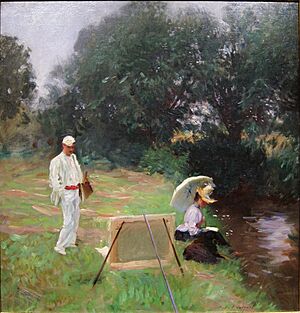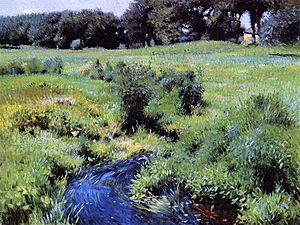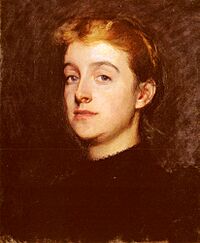Dennis Miller Bunker facts for kids
Quick facts for kids
Dennis Miller Bunker
|
|
|---|---|

Dennis Miller Bunker Painting at Calcot, John Singer Sargent, 1888
|
|
| Born | November 6, 1861 New York City
|
| Died | December 28, 1890 (aged 29) |
| Nationality | American |
| Education | Art Students League of New York, National Academy of Design, École des Beaux-Arts |
| Known for | Painting |
| Movement | American Impressionism |
| Awards | Third Hallgarten Prize (1885) |
Dennis Miller Bunker (born November 6, 1861 – died December 28, 1890) was an American painter. He was a key artist in developing American Impressionism. His paintings included bright landscapes and detailed portraits. Bunker was a major American painter of the late 1800s and friends with many famous artists. He sadly passed away at age 29 from meningitis.
Contents
The Life of Dennis Miller Bunker
Dennis Miller Bunker was born in New York City. His father, Matthew Bunker, worked for a ferry company. In 1876, Dennis began studying art at the Art Students League of New York and the National Academy of Design. By 1880, he was already showing his artwork in important exhibitions.
In 1881, Bunker showed a watercolor painting at the Boston Art Club. He continued to exhibit both oil paintings and watercolors there in the following years.
Studying Art in Paris
In 1882, Bunker traveled to Paris, France, to study at the École nationale supérieure des Beaux-Arts. He learned from famous artists like Jean-Léon Gérôme. In the spring of 1883, he explored the French countryside and the coast of Normandy with fellow students. They returned to their studies later that year. The next year, they spent the summer painting in Brittany. By the end of that year, Bunker was back in New York City.
Teaching and Meeting New Friends
In 1885, Bunker became a member of the Society of American Artists. That October, he moved to Boston to teach at the Cowles Art School. He was the main teacher for drawing, anatomy, and composition. He also had his first solo art show in Boston. Even with these successes, Bunker missed France.
He couldn't afford to stay in Boston during the summer or travel to Europe. However, in 1886, he accepted an invitation from artist Abbott Handerson Thayer to paint with him in South Woodstock, Connecticut. That same year, he met Isabella Stewart Gardner, who became a very helpful friend and supporter of his art.
Painting and Traveling
In 1887, Bunker painted many portraits. He spent the summer in Newburyport, Massachusetts with artist friends, including Henry Oliver Walker. In November, he met the famous painter John Singer Sargent in Boston. This was during Sargent's first working trip to America.
In 1888, Bunker received many requests to paint portraits of important people in Boston. These included members of the Gardner family. Bunker spent the summer in England, where he painted with Sargent and his family in Calcot. They painted during the day and played tennis in the evenings.

Later Years and Marriage
In the spring of 1889, Bunker left the Cowles Art School. He met Eleanor Hardy at a party, and they would marry the next year. That summer, Bunker stayed at a boarding house in Medfield, Massachusetts. This was his most productive time for painting. In the fall, he returned to New York and wrote to Eleanor every day. By this time, Bunker was friends with many well-known artists and writers.
In 1890, Bunker first showed his impressionist landscapes at the St. Botolph Club in Boston. He was offered a teaching job at the Metropolitan Museum of Art. In June, he visited an art colony in Cornish, New Hampshire, and in July, he returned to paint more in Medfield.
On October 2, 1890, Dennis Bunker married Eleanor Hardy in Boston. The couple then moved to New York. While visiting Eleanor's family in Boston for Christmas, Bunker became very sick. He passed away on December 28, 1890, at age 29. His friends, Stanford White and Augustus Saint-Gaudens, designed his tombstone. His friends also organized a special art show in his memory in 1891.
Dennis Miller Bunker's Artwork
Bunker's early paintings (around 1880-1882) often showed scenes of the sea, especially boats on the beach on Long Island. He would first make quick sketches and then create more finished paintings. His early portraits also showed great skill.
Paintings from France and America
While studying in Paris, Bunker's summer trips to the countryside led to a series of paintings of Larmor, a town in Brittany. These paintings often showed a church spire, a cemetery cross, or a single tree. These main subjects were painted as dark shapes against a bright sky. His pictures were known for their soft light and subtle colors.
After returning to America, Bunker continued to paint landscapes. His paintings from South Woodstock, Connecticut, still used strong contrasts between light and dark. But his colors became brighter and more vibrant.
Portraits and Impressionism
By 1887, Bunker finished his Portrait of Anne Page. This painting took a lot of effort but became one of his most touching works. It used soft colors and delicate shapes, similar to the styles of Thayer and James McNeill Whistler. Soon after, he painted many portraits for people in Boston. These were still serious in tone but showed more confidence, perhaps influenced by Sargent.
Bunker spent the summer of 1888 painting with Sargent. Although no paintings from this trip by Bunker have survived, the experience helped him greatly. Over the next two years, Bunker created a series of paintings that showed he was one of the first American artists to truly understand and use Impressionism. Paintings like In the Greenhouse (around 1888), Chrysanthemums (1888), The Pool, Medfield (1889), and Meadow Lands (1890) all feature rich colors and his unique "fish hook" brush strokes.

At the same time, Bunker's last figure paintings still followed his traditional art training. Jessica (1890), The Mirror (1890), and Eleanor Hardy Bunker (1890) used a limited range of colors and showed great elegance.
Dennis Miller Bunker's Legacy
Even though Dennis Miller Bunker was highly respected during his life, his work was mostly forgotten after his death in the 20th century. However, his teaching influenced many painters, including William McGregor Paxton and Lilla Cabot Perry.
A student of Paxton's, named R. H. Ives Gammell, worked hard to keep Bunker's reputation alive. He organized two exhibitions at the Museum of Fine Arts, Boston in the 1940s and wrote a book about Bunker in 1953. Today, there is new interest in Bunker's work. He is now seen as an artist who was both traditional and innovative.


